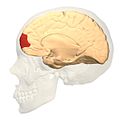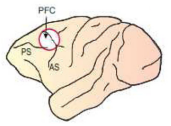Today, the Journal of Neural Engineering published rather an interesting paper. In it, they showed that they had been able to restore (and in some cases, improve) decision-making ability in primates through the use of an implanted prosthetic.
Sounds like something out of science fiction, doesn’t it?

The region of the brain responsible for decision-making and complex cognition is called the prefrontal cortex (PFC). Damage or disease which disrupts the very precise neural firing necessary for proper function in this area can lead to a range of problems with attention, decision-making and movement selection.
And that doesn’t just mean people aren’t sure what kind of cooldrink they want for lunch, or get distracted easily. These are also known as the ‘executive functions’ - being able to think about the future consequences of one’s actions, for example, or the ability to differentiate between good and bad, or knowing how to behave in a way that’s socially acceptable. Decisions which, if made poorly, can lead to unpleasant outcomes.
Researchers at Wake Forest Baptist Medical Center have taken a step forward towards being able to treat this sort of damage in people.
They were able to use an electronic prosthetic system to tap into the PFC of their test subjects - 5 rhesus macaques - and restore or, in some cases, improve neural function in this area.

For the study, the scientists trained their subjects to match multiple images on a screen until they were correct most - 70-75% - of the time on the easiest trials. A screen would show the monkeys an image, and then go blank for up to two minutes before the monkey was then shown a range of images, and had to choose the image which matched the original.

While the monkeys were conducting the exercise, a prosthetic neural implant recorded the firing patterns of a number of the neurons in the PFC. More precisely, the implant recorded the neural impulses only when the monkeys had made a correct match. The details for the mathematical model used - a multi-input multi-output nonlinear (MIMO) model - are available in the paper.
Then, the monkeys were given a potent drug which is known to disrupt cognitive activity. And, I must admit, this is where I giggled a bit - they gave the monkeys cocaine :P * snort *

It worked, though - the monkeys’ ability to correctly match images decreased by some 13%. Which is where that implant comes in - when it detected that the monkeys were likely to make a ‘wrong’ decision, and ‘played’ back the neural recording taken when the animals were choosing correctly.
Let’s be clear about that - the implant ‘played’ its recording BACK into the neurons whose activity it recorded. And ye gods, but it worked. In fact, not only did it restore the cognitive function that those naughty, naughty lines had taken away, but it actually _improved_ cognitive function by about 10% above normal. Even when the schnarf was still in the monkeys’ system!
According to the paper, it’s “the first successful application of neuroprosthesis in the primate brain designed specifically to restore or repair the disrupted cognitive function.”
So, next steps?
The study’s lead author, Dr Robert E. Hampson, says “based on the findings of this study, we hope in the future to develop an implantable neuroprosthesis that could help people recover from cognitive deficiencies due to brain injuries,”
As with anything of this sort, there’s always the caveat that it worked in the animal model, and has not yet been tried on humans. But still, it seems promising!
The full paper is available, free, online, at http://iopscience.iop.org/1741-2552/9/5/056012.
Reference:
Hampson, Robert E. (2012-09-13) Facilitation and restoration of cognitive function in primate prefrontal cortex by a neuroprosthesis that utilizes minicolumn-specific neural firing. Journal of Neural Engineering, 9(5), 056012. DOI: 10.1088/1741-2560/9/5/056012